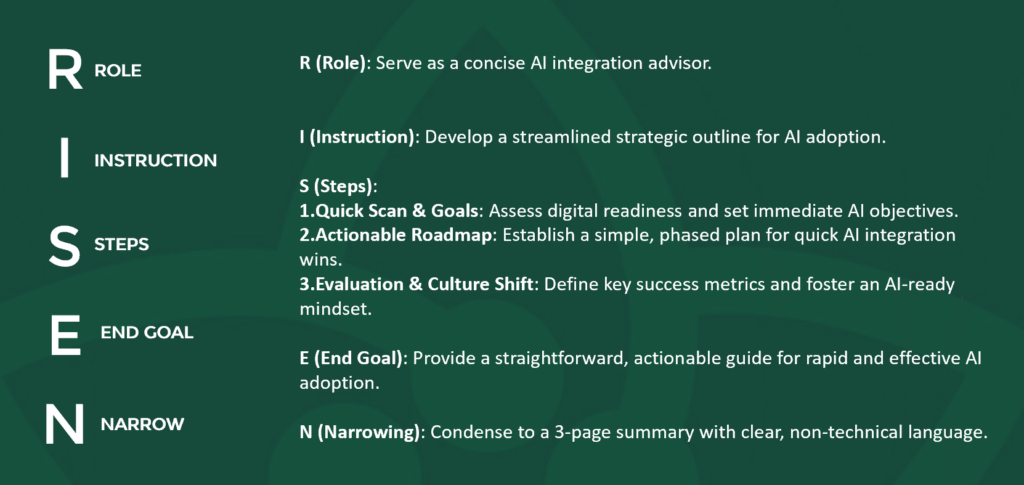
AI Prompt Design Importance and Challenges
The design of prompts plays a pivotal role in determining the success and efficacy of large language model chat bots. Prompt design encompasses various elements that contribute to optimal AI performance whereby having clear and concise instructions improves the result. One of the frameworks that encapsulates these essential elements is RISEN, which stands for Role, Instruction, Steps, End Goal, and Narrowing.
Let’s dive into each component of RISEN, explore its importance, and learn how to produce better results when you follow best practices from providers like ChatGPT,
Using RISEN for Effective AI Prompt Design
I first learned about RISEN while searching for formal prompt design frameworks mostly because there was limited credible guidance. The origins of RISEN can be credited back to Kyle Balmer on his promptentrepreneur TikTok channel. In the world of data and analytics, we have used LLMs to translate and convert business and data requirements:

R.I.S.E.N Prompt Components
Role: Ensures AI understands the role it needs to play for accurate responses.
Example: Act as a data consultant proposing a comprehensive strategy for implementing Salesforce Data Cloud in an organization.
Instruction: Provides clear directives to guide the AI’s actions.
Example: “Develop a proposal outlining the strategy, benefits, and implementation plan for Salesforce Data Cloud.”
Steps: Outlines the specific steps or components to follow.
Example:
- Start with an executive summary explaining the purpose and importance of Salesforce Data Cloud.
- Detail the key benefits of adopting Salesforce Data Cloud.
- Outline the step-by-step implementation plan, including data migration, integration, and user training.
- Provide a timeline and budget estimate for the implementation.
- Conclude with potential challenges and mitigation strategies.
End Goal: Defines the desired outcome of the prompt.
Example: Create a comprehensive proposal that convinces stakeholders of the value and feasibility of implementing Salesforce Data Cloud, ultimately leading to project approval and execution.
Narrowing: Sets constraints or requirements to refine the output.
Example: The proposal should be 2,000-2,500 words, use professional language, and include relevant data and case studies to support the arguments.
Final RISEN Prompt
The final compiled prompt looks like the following. Give it a shot in your AI Chatbot of choice!
Act as a Salesforce consultant proposing a comprehensive strategy for implementing Salesforce Data Cloud in an organization.
Develop a proposal outlining the strategy, benefits, and implementation plan for Salesforce Data Cloud.
Start with an executive summary explaining the purpose and importance of Salesforce Data Cloud.
Detail the key benefits of adopting Salesforce Data Cloud.
Outline the step-by-step implementation plan, including data migration, integration, and user training.
Provide a timeline and budget estimate for the implementation.
Conclude with potential challenges and mitigation strategies.
Create a comprehensive proposal that convinces stakeholders of the value and feasibility of implementing Salesforce Data Cloud, ultimately leading to project approval and execution.
The proposal should be 2,000-2,500 words, use professional language, and include relevant data and case studies to support the arguments. Challenges in AI Prompt Design
Despite its importance, AI prompt design presents several challenges…
Context Sensitivity: Designing prompts that are contextually relevant and sensitive to user intent can be challenging. Not all AI chatbots are built alike and the underlying data and context can vary.
Balancing Simplicity and Complexity: Finding the right balance between simple prompts for user understanding and complex prompts for detailed interactions is challenging. For example, in a financial planning AI, balancing prompts that are easy to understand for general users while providing in-depth analysis for financial experts requires careful design.
Dynamic Interaction: Designing prompts that adapt dynamically to user input and feedback can be complex. For instance, in a recommendation system, prompts need to evolve based on user preferences and interactions to deliver personalized recommendations effectively. For example, OpenAI’s ChatGPT has been designed per chat session to maintain continuity over time.
Multimodal Interaction: Integrating multiple modes of interaction, such as voice, text, and imagery, into prompt design adds complexity and opportunity for increasing context beyond what you can type. “A picture is worth a million words” which holds true for multi-modal generative AI.
Cultural Sensitivity: Designing prompts that are culturally sensitive and inclusive requires consideration of diverse user backgrounds and preferences. For example, in a language translation AI, prompts need to account for linguistic nuances and cultural differences to avoid misunderstandings.
Despite these challenges, the RISEN framework provides a structured approach for interating with large language models while optimizing prompt design.
Bottom Line on Prompt Design
While crafting prompts for AI can be tricky, the RISEN framework and consistent approach to build good prompts. By focusing on role, instruction, and other key principles, you can confidently tackle any large language model chat bot and extract maximum value!
